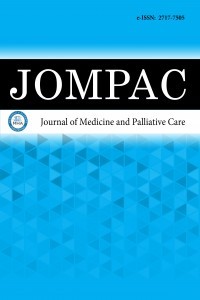1. Cheung NH, Napolitano LM. Tracheostomy: epidemiology, indications, timing, technique, and outcomes. Respir Care 2014; 59: 895-919.
2. Freeman BD, Isabella K, Lin N, Buchman TG. A meta-analysis of prospective trials comparing percutaneous and surgical tracheostomy in critically ill patients. Chest 2000; 118: 1412-8.
3. Hazard P , Jones C, Benitone J. Comparative clinical trial of standard operative tracheostomy with percutaneous tracheostomy. Crit Care Med 1991; 19: 1018-24.
4. Durbin CG, Jr. Indications for and timing of tracheostomy. Respir Care 2005; 50: 483-7.
5. Zengin M, Baldemir R. Investigation of the global outcomes of acute respiratory distress syndrome with the effect of COVID-19 in publications: a bibliometric analysis between 1980 and 2020.
6. Zengin M, Karaca O. A bibliometric analysis of academic publication about intoxication in the period from 1975 to 2020: a global and medical view. Osmangazi J Med 2021; 44: 148-61.
7. Muslu Ü, Demir E. Development of rhinoplasty: yesterday and today. Med Sci 2019; 23: 294-301.
8. Doğan G, İpek H. The Development of necrotizing enterocolitis publications: a holistic evolution of global literature with bibliometric analysis. Eur J Pediatr Surg 2020; 30: 293-303.
9. Zengin M, Karcioglu AM. Do not invade, just support. Bratisl Lek Listy 2022; 123: 218-26.
10. Kiraz S, Demir E. Global scientific outputs of schizophrenia publications from 1975 to 2020: a bibliometric analysis. Psychiatric Quarterly 2021; 92: 1725-44.
11. Doğan G, Karaca O. A bibliometric analysis of the field of anesthesia during 2009–2018: a bibliometric analysis of anesthesia. Brazilian J Anesthesiol 2020; 70: 140-52.
12. Kiraz M, Demir E, Özdemir Ö. An international bibliometric study of scientific articles on intracranial aneurysms. Neuroradiol J 2021; 34: 482-93.
13. Van Eck NJ, Waltman L. Software survey: VOSviewer, a computer program for bibliometric mapping. Scientometrics 2010; 84: 523-38.
14. The World Bank. The World Bank Data 2020 15 September 2021.
15. Delaney A, Bagshaw SM, Nalos M. Percutaneous dilatational tracheostomy versus surgical tracheostomy in critically ill patients: a systematic review and meta-analysis. Crit Care 2006; 10: R55.
16. Rumbak MJ, Newton M, Truncale T, Schwartz SW, Adams JW, Hazard PB. A prospective, randomized, study comparing early percutaneous dilational tracheotomy to prolonged translaryngeal intubation (delayed tracheotomy) in critically ill medical patients*. Crit Care Med 2004; 32: 1689-94.
17. Young D, Harrison DA, Cuthbertson BH, Rowan K, TracMan Collaborators ft. Effect of early vs late tracheostomy placement on survival in patients receiving mechanical ventilation: the tracman randomized trial. JAMA 2013; 309: 2121-9.
18. Stauffer JL, Olson DE, Petty TL. Complications and consequences of endotracheal intubation and tracheotomy. A prospective study of 150 critically ill adult patients. Am J Med 1981; 70: 65-76.
19. Ciaglia P , Firsching R, Syniec C. Elective percutaneous dilatational tracheostomy. A new simple bedside procedure; preliminary report. Chest 1985; 87: 715-9.
20. Griggs WM, Worthley LI, Gilligan JE, Thomas PD, Myburg JA. A simple percutaneous tracheostomy technique. Surg Gynecol Obstet 1990; 170: 543-5.
21. Griffiths J, Barber VS, Morgan L, Y oung JD. Systematic review and meta-analysis of studies of the timing of tracheostomy in adult patients undergoing artificial ventilation. BMJ 2005; 330: 1243.
22. David AP, Russell MD, El-Sayed IH, Russell MS. Tracheostomy guidelines developed at a large academic medical center during the COVID-19 pandemic. Head Neck 2020; 42: 1291-6.
23. Gosling AF, Bose S, Gomez E, et al. Perioperative considerations for tracheostomies in the era of COVID-19.
24. Aygencel G, Kemaloğlu YK. Tracheostomy applications in critically-ill COVID-19 patients. Kulak Burun Boğaz Baş Boyun Cerr Derg 2020; 28: 84-9.
25. Carr MM, Poje CP , Kingston L, Kielma D, Heard C. Complications in pediatric tracheostomies. Laryngoscope 2001; 111: 1925-8.
26. Bach JR, Saporito LR. Criteria for extubation and tracheostomy tube removal for patients with ventilatory failure: a different approach to weaning. Chest 1996; 110: 1566-71.
27. Guilleminault C, Simmons FB, Motta J, et al. Obstructive sleep apnea syndrome and tracheostomy: long-term follow-up experience. Archives of Internal Medicine 1981; 141: 985-88.
28. McGrath BA, Brenner MJ, Warrillow SJ, et al. Tracheostomy in the COVID-19 era: global and multidisciplinary guidance. Lancet Respir Med 2020; 8: 717-25.
29. Angel L, Kon ZN, Chang SH, et al. Novel percutaneous tracheostomy for critically ill patients with COVID-19.
30. Martin-Villares C, Perez Molina-Ramirez C, Bartolome-Benito M, Bernal-Sprekelsen M, Collaborative Group COE. Outcome of 1890 tracheostomies for critical COVID-19 patients: a national cohort study in Spain. Eur Arch Otorhinolaryngol 2021; 278: 1605-12.

